From stud to straw, and all the way to the milking string, a recent Midwestern bus tour showcased each step of the process of creating elite genetics.
Over four days, more than 220 visitors hailing more than 20 different countries were treated to a behind-the-scenes tour that included visiting herds home to some of the biggest names in genomics, the facilities where up-and-coming bulls are housed and collected, and a peek into reproductive technologies like semen sexing that are on their way to revolutionizing the dairy industry as we know it.
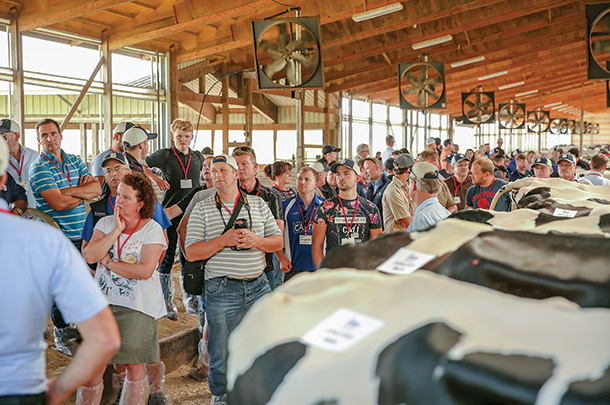
Nate Zwald, ABS Global chief operating officer dairy, was excited to connect dairymen with the opportunity to learn from one another. “I think everybody is thirsty for knowledge,” he said. “When we get producers from around the world together in one place, you can see them learning from each other. That’s an incredible feeling.”
The breeders behind the bulls
Browsing through the most recent lists of both top-genomic and proven bulls and young animals, a few prefixes stand out: “De-Su,” “Denovo” and “Bomaz.” Tour attendees had the privilege of viewing firsthand the herds producing these high-ranking males and females and hearing directly from the breeders making it happen.
De-Su Holsteins/De Novo Genetics
An early adapter to genomic selection, Darin Meyer has paved the way for De-Su Holsteins LLC with disciplined breeding principles that have influenced not only his own commercial herd but are also leaving a permanent mark on the global genetics of the black-and-white breed.
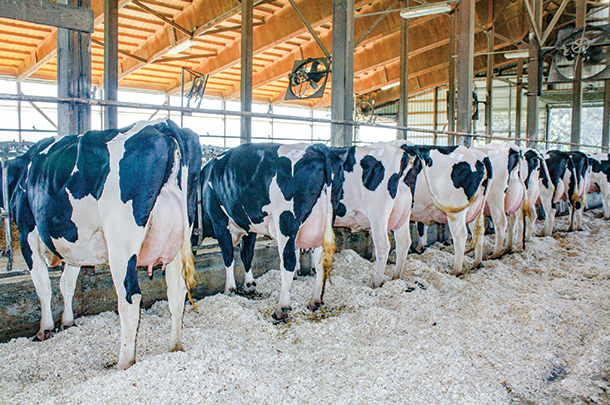 Based in New Albin, Iowa, Meyer and his family milk around 1,900 cows between two locations. Driven by a desire to breed for cows that could thrive in a freestall environment, Meyer latched onto genomics as a way to achieve a high-producing, healthy herd.
Based in New Albin, Iowa, Meyer and his family milk around 1,900 cows between two locations. Driven by a desire to breed for cows that could thrive in a freestall environment, Meyer latched onto genomics as a way to achieve a high-producing, healthy herd.
In less than a decade’s time, his calculated investments in high-numbered females like Sully Shottle May, coupled with strategic matings to produce families like that of De-Su BW Marshall Georgia, have populated the published Holstein lists and proofs with De-Su descendants. Among the many notable bulls are Observer, Balisto, Topsy, Gillespy and Spectre, just to name a few.
In 2016, De-Su Holsteins entered a joint venture with ABS to form De Novo Genetics. In this arrangement, elite females and males are created and the most elite young bulls head to ABS. Donor females are housed at De-Su’s 450-cow freestall barn near Caledonia, Minnesota.
Meyer serves as manager for De Novo, giving him the ability to maintain daily management over breeding decisions; he works closely with ABS senior geneticist for dairy strategy Ryan Starkenburg and ABS global dairy sire acquisition manager Devan Funk. Now, two years later, approximately half the bulls brought to the stud are the result of this strategic breeding program, distinguished by the “Denovo” prefix.
“As far as genetic selection, to me, I think that’s what makes De Novo successful,” Meyer said, noting selections are based on a “hybrid” of genomic TPI and NM$. “Everything is selected toward making more money commercially milking cows.”
Bomaz Inc.
Built on the philosophy of “breeding the best to the best,” Bomaz Inc. has found success with a concentrated focus on two key areas: health and production traits.
“I like to breed ‘working cows’ that go through the parlor trouble-free,” Bob Zwald said. The multi-generation dairy farm in Hammond, Wisconsin, includes Bob and his wife, Kay, along with their children and spouses: Annette (Zwald) and Steve Schalla, and Tom and Ashley Zwald.
“Genetics has always been my passion,” Bob said. “I’m always looking at bull books, using new technologies as they become available.”
In fact, Bomaz began using embryo transfer (ET) as early as the mid-1970s as a way to improve the herd, and they continue to use ET and in vitro fertilization programs aggressively today to propel the genetics of the 900-cow milking herd forward. The top 1 percent of heifers (based on genomic Net Merit) are flushed to the highest bulls available. Bob has “really embraced genomics,” breeding only to genomic sires. Further, the sexed semen used in the ET program is yielding results as good or better than conventional semen.
Bob is also pleased with the results in his barn, noting udders and feet and legs are “better than ever,” and the group of exclusively genomic-bred 2-year-olds calving in right now are “probably the best group of heifers we’ve ever had.” Some of the daughters Bob is most excited about right now include those from Silver, Josuper and Delta.
Breedings from Bomaz continue to catch attention far beyond their own freestall barn. In fact, the top-genomic female in the breed (as of October 2018) bears Bomaz in her prefix and the top side of her pedigree: Bomaz Skywalker 8609-ET (GTPI 2957).
Bomaz Skywalker-ET is also the sire to 14 of the top 25 females on the Holstein Association’s October GTPI females list. This chart-topping bull goes back to a Mogul grand dam that produced 40,000 pounds of milk per year and never missed a beat breeding back. “She’s the kind of cow that makes us money,” Bob added.
Other up-and-comers from Bomaz also include Bomaz Yoda 8429 (GTPI 2961) and Bomaz Skywalker 2449 (GTPI 2936), along with Bomaz Medley 2437-ET, the top-ranking polled bull and also No. 6 in the breed for NM$.
View more photos here or click on the image above.
Sire care and collection
The top young bulls from De Novo, Bomaz and about 20 other U.S. breeders are genomically tested before making their way to ABS’s Dekorra facilities, located just north of Madison. They come in at about 6 weeks old, starting off in individual hutches and moving to super hutches after weaning.
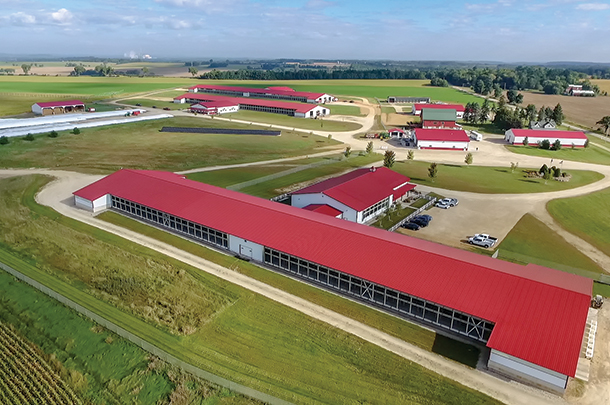
At 6 months old, bulls are transferred to the isolation unit for health testing, undergoing more than 70 tests over an eight-week period. Once cleared, collection starts on bulls around 9 to 10 months old.
Keeping up with the mounting demand for sexed semen has driven the company to invest in more collection facilities. A former layover barn that used to house bulls waiting to be daughter-proven has recently been converted to a second on-site collection barn, this one dedicated to genomic sires.
In the U.S., the company owns more than 770 dairy bulls, with around 350 on collection. Semen is collected four times a day, five days a week to supply the quantity needed for sexed genetics. They are also focusing on continued expansion of beef genetics, specifically those that complement crossing with dairy, as part of the company’s beef-on-dairy program.
Technology at work: Gene editing, sexed semen
A short drive from the bull barns, IntelliGen Technologies is the rapidly growing biotech division of Genus plc, ABS Global’s parent company. This is home to Sexcel Sexed Genetics, a technology developed over the last 10 years to create female-producing semen. At a rate of 17,000 to 18,000 times per second, a laser detects female cells and incapacitates undesirable male sex cells on an area no bigger than the dot on the end of a pen.
This is also where discovery-level work in the gene-editing field is bringing the dairy industry one step closer each day to improved animal health. Genus chief scientific officer Jonathan Lightner explained disease resistance has been the focus thus far, particularly for the porcine reproductive and respiratory syndrome (PRRS) virus.
Scientists are now able to remove one of the 40,000 genes in a pig, essentially “shutting it off” and preventing susceptibility. “When a pig is homozygous for the loss of that gene, it is fully resistant to a disease known as PRRSv,” Lightner said. “PRRSv takes about a billion dollars a year out of the pork production industry.”
Similarly, an active-stage discovery project is underway to improve resilience to bovine respiratory disease (BRD). The company sees this as an area of measurable economic value that could be improved more efficiently than with natural breeding – and perhaps with greater social acceptance than going after pure production traits.
“We’re really focused on disease resistance because that’s the one where it becomes an easy thing for people to accept … keeping animals healthier, reducing the need for other therapeutic treatments,” Nate Zwald noted. “The first disease we will target in bovines is BRD.”
Genetics in action
Taking it full circle, the tour also featured two dairies with impressive lineups of young cows resulting from the advancements in genomics and technologies like sexed semen at Weiss Family Farms Inc., in Durand, Wisconsin, and Johnson’s Rolling Acres in Peterson, Minnesota.
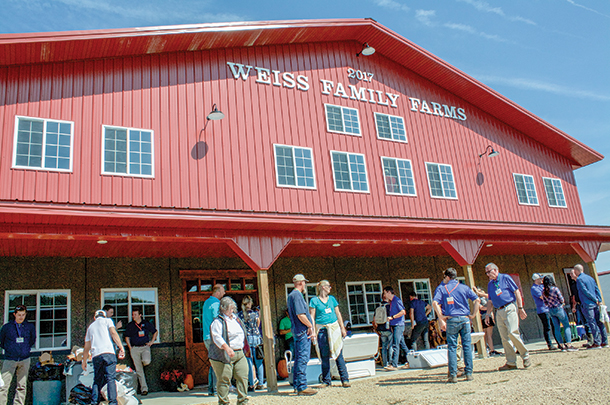 Weiss Family Farms Inc., operated by Don and Colette Weiss and several family members, has incorporated genetic strategy while growing from 54 cows to 1,000 cows over the last three-and-a-half decades. Emphasis has been on NM$, which has helped to moderate cow size and produce long-lasting cows thriving in the sand-bedded barns and with the dairy’s 50-stall rotary parlor built last year.
Weiss Family Farms Inc., operated by Don and Colette Weiss and several family members, has incorporated genetic strategy while growing from 54 cows to 1,000 cows over the last three-and-a-half decades. Emphasis has been on NM$, which has helped to moderate cow size and produce long-lasting cows thriving in the sand-bedded barns and with the dairy’s 50-stall rotary parlor built last year.
Three-quarters of the dairy bulls used are genomic sires, and the farm is breeding the bottom end of the herd to beef semen. Currently, they are using Achiever, Medley, Raiden and Skyfall.
Across the Mississippi River, the Johnson family is milking 1,280 cows in a double-18 milking parlor. Owned and operated in a partnership between three brothers and three nephews, the high-producing herd hones in on traits like feet and legs and components.
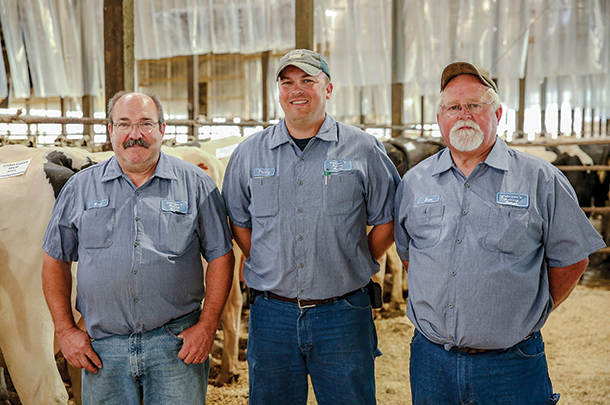 Fourth-service cows here are also bred to beef semen. Recognized for excellent herd health, reproductive performance and management, Johnson’s Rolling Acres serves as a recipient herd for De-Su Holsteins, providing heifers for 10 to 15 ETs each week. The majority of bulls used here are genomic as well, including Achiever, Medley, Josuper, Kenobi and Firefly.
Fourth-service cows here are also bred to beef semen. Recognized for excellent herd health, reproductive performance and management, Johnson’s Rolling Acres serves as a recipient herd for De-Su Holsteins, providing heifers for 10 to 15 ETs each week. The majority of bulls used here are genomic as well, including Achiever, Medley, Josuper, Kenobi and Firefly.
Looking ahead
With the speed at which the gamut of reproductive technologies from genomics to sexed semen to beef-on-dairy breeding have transformed the dairy industry in the last 10 years alone, and the potential for gene editing, Nate Zwald sees only continued advancement in the future.
“If we were sitting here in 2008, you would have never thought things would be the way they are, and that’s the exciting part of this industry,” he said. “It will continue to evolve, and I think ABS and Genus are well-positioned because our focus on research and development will help lead many of those changes. ”
The ABS Global Experience took place Sept. 11-14, 2018. ![]()
PHOTO 1: The Zwald family is behind the well-known Bomaz prefix, including parents Bob and Kay, along with their children and their spouses, Annette and Steve Schalla and Tom and Ashley Zwald, and a growing generation of future farmers. ABS Global’s COO-Dairy Nate Zwald (left) is also Bob and Kay’s son. Photo courtesy ABS Global.
PHOTO 2: More than 220 visitors from around the world participated in the ABS Global Experience, a four-day tour that canvassed Wisconsin and Minnesota, visiting the company’s facilities and key farms. Photo courtesy ABS Global.
PHOTO 3: Among the elite donor females at De Novo are the first cow on the left, Klassic Rubicon Bubblebath, the dam of Crosby and Galant, and next to her, Endco Rubicon Cora, who has eight sons in A.I., including Crimson. Photo by Peggy Coffeen.
PHOTO 4: ABS Global’s Dekorra facilities are the site of bull housing and collection. Photo courtesy ABS Global.
PHOTO 5: The Weiss family recently built a rotary milking parlor for their 1,000-cow herd. They emphasize Net Merit and strive for moderate stature. Photo by Peggy Coffeen.
PHOTO 6: Johnson’s Rolling Acres uses mostly high-genomic bulls and provides recipients for embryos from De-Su Holsteins. From left to right are Mark, Trinity and Brad Johnson. Photo courtesy ABS Global.
See more photos from the four-day tour here.





